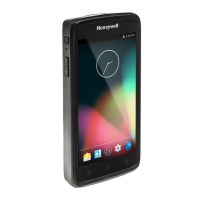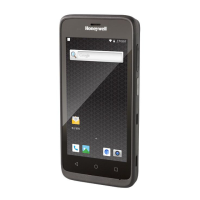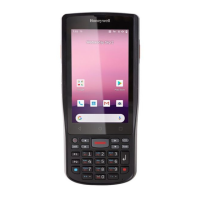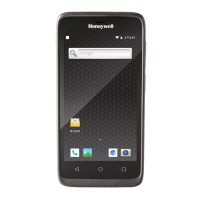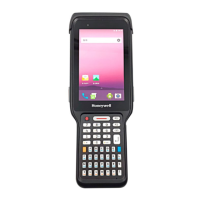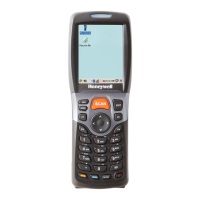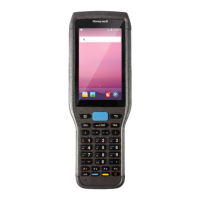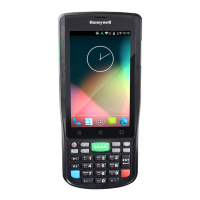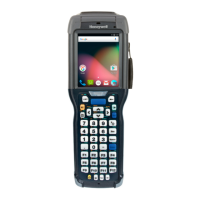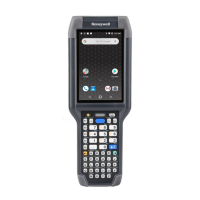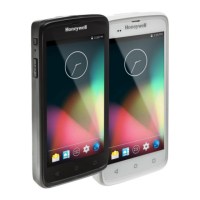
Do you have a question about the Honeywell ScanPal EDA50K and is the answer not in the manual?
| HDD capacity | 128 GB |
|---|---|
| Audio (L/R) in | 1 |
| Composite video in | 0 |
| DVI-D ports quantity | 5 |
| DVI-I ports quantity | 4 |
| USB 2.0 ports quantity | 8 |
| Ethernet LAN (RJ-45) ports | - |
| Component video (YPbPr/YCbCr) in | 7.5 |
| USB 3.2 Gen 1 (3.1 Gen 1) Type-A ports quantity | 1.9 |
| Display diagonal | 4 \ |
| External display | No |
| Touch technology | Multi-touch |
| Touchscreen type | Capacitive |
| Display resolution | 480 x 800 pixels |
| Flash memory | 16 GB |
| Internal memory | 0.002 GB |
| Compatible memory cards | MicroSDHC |
| Maximum memory card size | 32 GB |
| Processor family | Snapdragon |
| Processor frequency | 1.2 GHz |
| Processor manufacturer | Qualcomm |
| Operating system version | 4.4 |
| Operating system installed | Android |
| Data network | EDGE, GSM, LTE, WCDMA |
| Wi-Fi standards | 802.11a, 802.11b, 802.11g |
| Bluetooth version | 4.0 |
| GSM bands supported | 900, 1800 MHz |
| Security algorithms | 802.1x RADIUS, AES, EAP-TLS, EAP-TTLS, TKIP, WEP, WPA, WPA-PSK, WPA2 |
| WCDMA bands supported | 900, 2100 MHz |
| Rear camera resolution (numeric) | 5 MP |
| Storage temperature (T-T) | -20 - 60 °C |
| Operating temperature (T-T) | -10 - 50 °C |
| Operating relative humidity (H-H) | 10 - 90 % |
| Battery voltage | 3.8 V |
| Battery capacity | 4000 mAh |
| Battery life (max) | 12 h |
| AC adapter output current | 2 A |
| AC adapter output voltage | 5 V |
| Battery recharge time (off) | 4 h |
| Product color | Black |
| Keyboard layout | Alphanumeric |
| International Protection (IP) code | IP54 |
| Depth | 24.5 mm |
|---|---|
| Width | 73 mm |
| Height | 164 mm |
| Weight | 300 g |
A concise summary of the ScanPal EDA50's key attributes and functionalities.
Detailed information about the device's battery, including charging, maintenance, and indicators.
Instructions on how to charge the device's battery.
Step-by-step guide for replacing the device's battery.
Explanation of the battery status indicator icons displayed on the device.
How to customize the device's power indicator behavior and settings.
Methods to view the current battery level and estimated remaining time.
Tips and recommendations for maximizing battery lifespan and performance.
Guidance on charging the device while it is actively being used.
How to activate Airplane mode to conserve power by disabling wireless radios.
Instructions on how to turn on the ScanPal EDA50 device.
Steps to unlock the device's screen after it has been powered on.
Explanation of the indicator light that shows the scanner's status.
How to adjust the screen's brightness for optimal readability.
Overview of the device's audio capabilities and settings.
How to control the volume for calls and messages using the side buttons.
Instructions for activating the vibration alert for notifications and calls.
Detailed configuration options for sound and notification settings.
Guide on how to insert a Micro SD card for expanded storage.
Methods for transferring files between the device and a computer.
Steps to access and view files stored on the device using File Explorer.
Information about available accessories for the EDA50 device.
Explanation of the device's graphical user interface and its components.
Description of the primary screen displayed after the device boots up.
Details on the physical keys and their functions on the device.
Explanation of the icons displayed in the device's status bar.
How to customize the functions assigned to the device's scan keys.
How to access and view system notifications and messages.
Procedures for managing system messages received by the device.
Steps to customize the home screen by adding or removing application icons.
How to add applications to the common application bar for quick access.
Using the Google search engine to find information on the device or the internet.
Explanation of various finger gestures used to interact with the touch screen.
How to manually configure the device's time zone settings.
Overview of Honeywell's software applications available on the device.
Instructions for developers to enable advanced system options.
An overview of the integrated scanner's features, performance, and data transfer methods.
Using scan wedge to input scanned data as keyboard input into applications.
How to modify various scanning parameters and configurations for optimal use.
Procedures for resetting all scan settings to their factory defaults.
Default configurations for scanning functions like data processing, symbology, and image settings.
Settings for configuring how scanned barcode data is processed and formatted.
Enabling barcodes to automatically launch the device's web browser.
Configuring how scanned data triggers specific application intents.
Enable or disable various barcode symbologies for scanning operations.
Settings related to image processing and rendering for scanning.
Configuration options for the device's scan trigger behavior.
How the device provides feedback during scanning operations.
Step-by-step instructions on how to successfully scan barcodes using the device.
Overview of the device's voice and data communication capabilities, network types supported.
Steps required to set up and make calls using a SIM card and activating UMTS service.
How to initiate a phone call from the device's dialer interface.
Instructions for receiving and answering incoming calls on the device.
How to multitask and use other applications while on an active call.
Procedures for making emergency calls, even without a SIM card or service.
Customizing various parameters for phone calls, such as ringtones and voice mail.
Information about the device's 5-megapixel color camera, its location, and gallery access.
How to modify camera settings for photos and videos, including zoom.
Techniques for zooming in and out of the camera's view using touch gestures.
How to adjust various camera parameters for optimal photo capture.
Step-by-step instructions for capturing still images with the camera.
Guidance on how to record video clips using the device's camera.
How to adjust video recording parameters before or during shooting.
Overview of the terminal's configuration options and where to access them.
How to access the main settings menu for device configuration.
An explanation of how the device's settings are organized for easy navigation.
Settings for connecting to Wi-Fi, mobile data, Bluetooth, and VPN networks.
Step-by-step guide to connecting the device to available wireless networks.
Instructions for setting up and connecting to VPNs for secure remote access.
Steps to add new VPN connections to the device's settings.
How to establish a connection to a configured VPN.
Procedures for modifying existing VPN connection details.
How to configure security protocols like WPA2, WPA, and certificates for wireless connections.
Information about using digital certificates for network access and validation.
Procedures for obtaining and installing digital certificates onto the device from an SD card.
How to manage or remove installed digital certificates from the device.
Settings related to the device's core hardware functions like sound, display, memory, and battery status.
Configuration options for device sounds, ringtones, and notification alerts.
Settings for screen brightness, wallpaper, screen timeout, and orientation.
Information on available storage space and memory usage on the device.
Status and usage data for the device's battery, including charge level.
Overview of installed and currently running applications on the device.
Settings for customizing the device's appearance, input methods, and security.
How to enable or disable location services, using Google and GPS data.
Configuration of screen lock, administrator privileges, and data storage security.
Settings for language, keyboard layout, and input method customization.
Options for backing up device data and resetting the device to factory defaults.
Specific settings provided by Honeywell for device functionality and customization.
Redefining the functions assigned to the device's physical scan keys.
Configuring the lighting modes for the battery indicator LED.
Configuring the device's imager and various scanning parameters for optimal performance.
Setting up user accounts, such as email or network accounts, on the device.
Step-by-step process for adding new accounts to the device.
System-level settings including date, time, auxiliary functions, and printing options.
Configuration of the device's date, time, and timezone settings.
Settings for supplementary features like font size and text-to-speech output.
Configuration options for managing printing from the device.
Displays system information about the device, such as model and version.
How to establish and manage Bluetooth connections with other devices.
Step-by-step guide for pairing the device with other Bluetooth devices.
How to adjust various Bluetooth related settings, such as visibility timeout.
Making the EDA50 discoverable for other Bluetooth devices.
How to change the name of a paired device or remove it from the list.
Methods for data transfer using serial ports and USB connections with accessories.
Information about using NFC technology for short-range wireless data transfer with tags.
Instructions for downloading and installing software updates via the technical support website.
How to upgrade applications using the AutoInstall feature by copying files to a specific folder.
Procedure for upgrading the device using a composite key file and specific button combinations.
How to perform manual software upgrades via the Recovery Menu using an SD card.
Methods for restarting the device if it becomes locked or unresponsive.
Restarting the terminal and initializing it to resolve issues.
How to reset the device to its original factory configuration, clearing user data.
Steps to resolve application responsiveness issues by restarting the terminal.
Comprehensive guide to restoring the device to its original factory state, including warnings about data loss.
Instructions on how to safely clean the device's exterior parts using approved solvents.
Procedures for disinfecting the terminal using approved chemical solutions for hygiene.
Details on the device's physical dimensions, weight, durability standards, and environmental sealing.
Specific measurements of the device's length, width, and thickness.
Information on the device's resistance to tumbling and accidental drops from specified heights.
Details on the battery capacity, voltage, and charging power specifications.
Technical details of the rechargeable Li-ion battery used in the device.
Specifications for the device's charging power input requirements.
Operating and storage limits for temperature and humidity the device can withstand.
The range of ambient temperatures the device can operate within safely.
The temperature range suitable for storing the device when not in use.
Details about the device's screen resolution, size, and viewing capabilities.
List of languages supported by the device's software for user interaction.
Supported barcode symbologies for scanning, categorized into 1D, 2D, and Postal codes.
List of supported one-dimensional barcode types that the scanner can read.
List of supported two-dimensional barcode types, such as QR codes.
List of supported postal barcode symbologies for shipping and mail.
Information on the scanner's performance range, reading distance, and depth of field.
